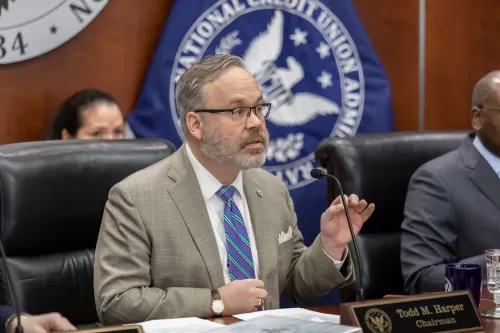NCUA Chairman Todd M. Harper during a meeting of the NCUA Board.
As Prepared for Delivery on June 22, 2023
Thank you, Martha and Leilani, for your presentation and your efforts to support the creation of new credit unions. I also thank the many team members in the Office of Credit Union Resources and Expansion for their work on several important initiatives, including field-of-membership expansions, small credit union training, Community Development Revolving Loan Fund grants and loans, and the subject of today’s briefing, new charters. Last, but not at all least, CURE’s work fielding thousands of questions about deposit insurance in March and April was above and beyond. So, thank you to everyone in CURE for a job well done.
A core mission of the NCUA is chartering new credit unions. Indeed, new credit unions are vital to maintaining a dynamic financial system — one that is growing, thriving, and meeting the evolving financial needs of our citizens and their communities.
On that note, thank you, Vice Chairman Hauptman, for your steadfast leadership on the critical issue of new charters. Your leadership has expedited the process and helped ensure that more communities and individuals can have their financial needs met through the cooperative financial system. I also thank Board Member Hood for his leadership on the issue of promoting greater financial inclusion as a core function of the agency’s work.
As Martha noted during her presentation, the NCUA has taken several recent steps to modernize and improve the chartering process. CURE has overhauled the Federal Credit Union Charter Application Guide and its supporting documents.1 The updated material gives organizers a better understanding of the state and federal options available and offers supplemental guidance for states to reference in their interactions with organizers.
Instead of applications taking years to be approved, Martha and her team have reduced the time to review and approve a complete application to approximately 130 days from start to finish. As such, the number of new charters increased from just one in 2020 to four each in 2021 and 2022.
Additionally, as Martha noted, 13 more applications are in the approval pipeline and nearing completion. While these numbers by no means reduce the decline in the overall number of credit unions — as the consolidation of credit unions and banks have been consistent for decades across a variety of economic and regulatory cycles — they are a positive step forward.
Also, as Leilani noted, we have been exploring how to address the catch-22 of chartering: Which comes first, the capital or the charter? The organizers need capital to get a charter, but they can’t get a charter without the capital. This chicken-or-egg dynamic often leaves organizing groups discouraged.
To resolve this frustration, the NCUA is working to pilot provisional charters. A provisional charter would allow organizing groups to demonstrate the capacity to start a credit union which would, in turn, facilitate their efforts to raise needed capital. In this pilot, the NCUA could grant an organizing group a charter if all they require is finalizing all their capital requirements. Under the pilot, the organizers would provide a capital funding plan and agree to secure their necessary funding commitments within 12 months.
A provisional charter is an excellent solution to the chicken-and-egg chartering problem, but I also know that it’s hard to raise capital even if you have a charter. So, that period for organizing groups to secure funding is the focus of my first question. Martha and Leilani, could that period be extended beyond one year if groups are unable to secure needed capital?
Thank you for that response. In some instances, it may not be possible for groups to secure such funding in time. So, I appreciate the flexibility.
Additionally, I would like to see the team in CURE explore the pooling of capital for starting new credit unions like the FDIC’s Mission-Driven Bank Fund launched in 2021.2 Such a fund in the credit union space could allow organizing groups to more easily obtain the much-needed capital needed to start new credit unions. Martha, would you and your team in CURE research this option and report back to the Board on the feasibility of and recommendations for creating such a fund?
Thank you. Finally, slide 19 of your briefing indicates plans to roll out the provisional charter pilot program for comment before the year’s end. Will this require any further action by the NCUA Board?
Thank you for clarifying that. It’s important for stakeholders to understand the process and the steps necessary to implement such a pilot properly. I stand ready to work with the team in CURE and my fellow Board members to make this provisional charter pilot a reality.
In sum, the NCUA is making meaningful improvements to its chartering process to bring new and more federal credit unions into the system. In doing so, we are providing more consumers with greater access to safe, fair, and affordable services under the cooperative model. The chartering of a new credit union is often the culmination of years of high hopes and hard work by organizers. We need to hone our tools and processes to make those dreams come true.
That concludes my remarks. I now recognize Vice Chairman Hauptman.
1 See https://ncua.gov/regulation-supervision/manuals-guides/federal-credit-union-charter-application-guide/introduction.
2 See Mission-Driven Bank Fund available at https://www.fdic.gov/regulations/resources/minority/mission-driven/index.html.




